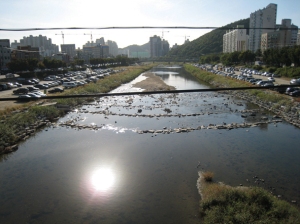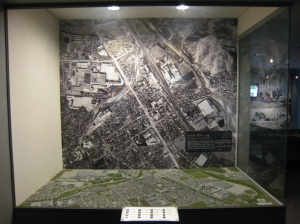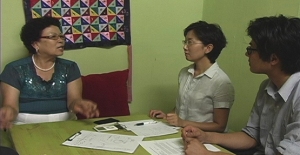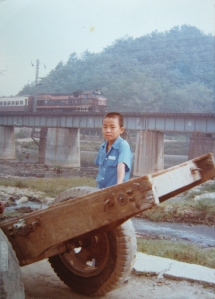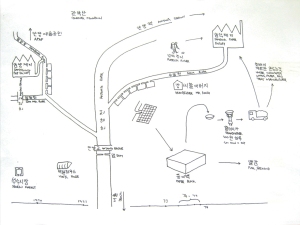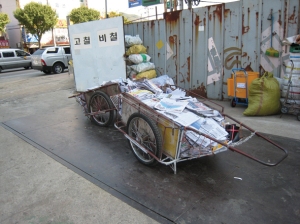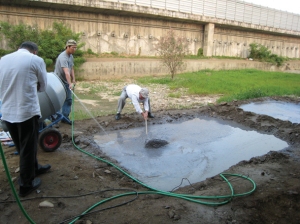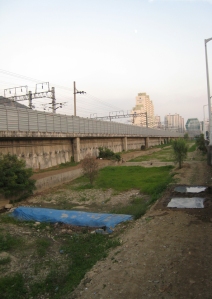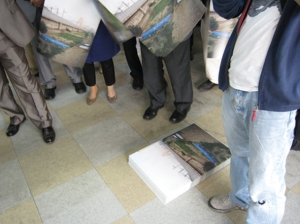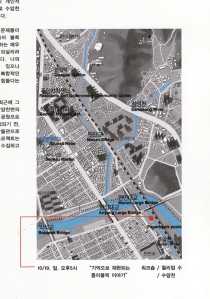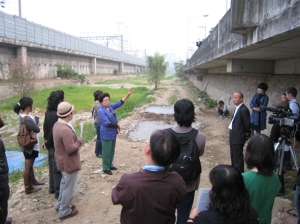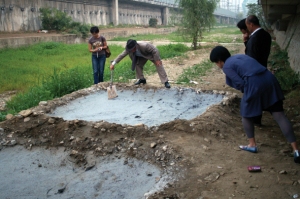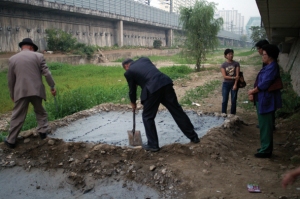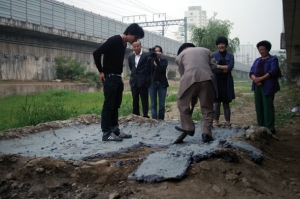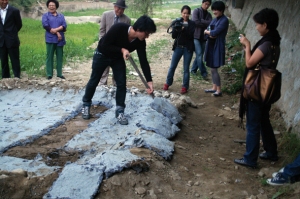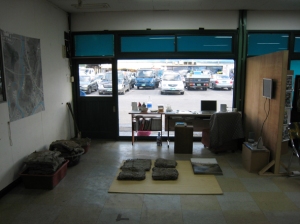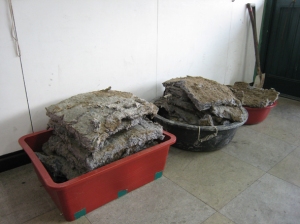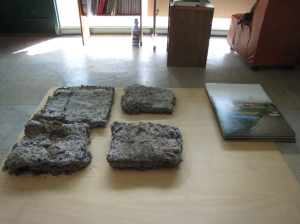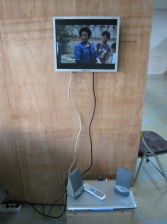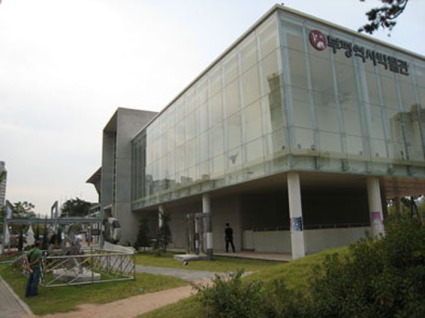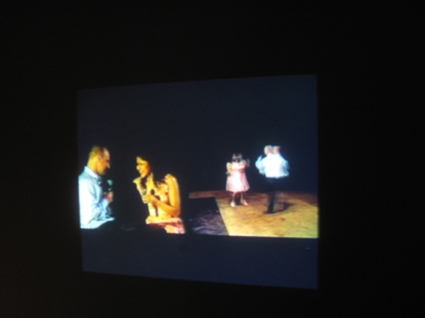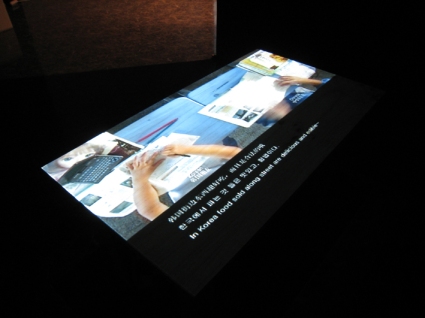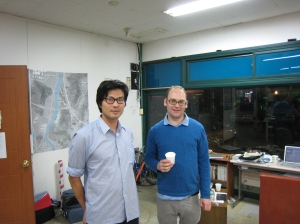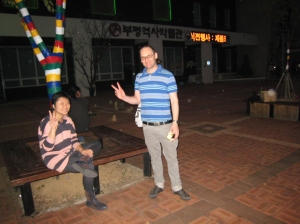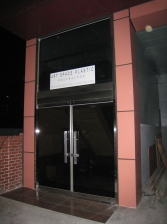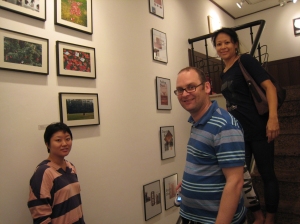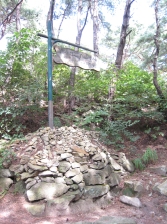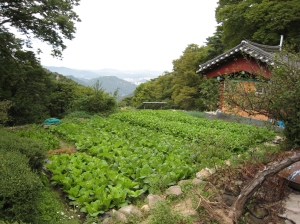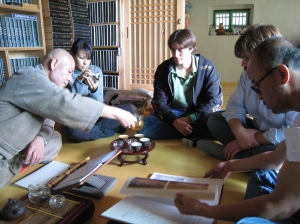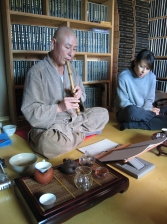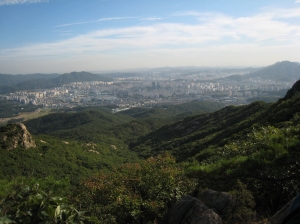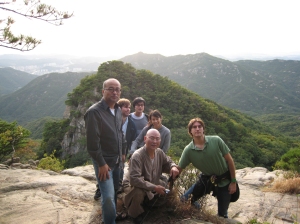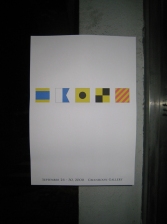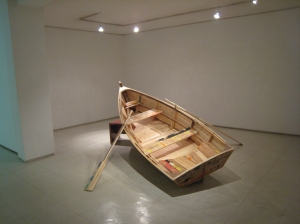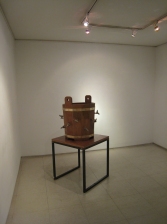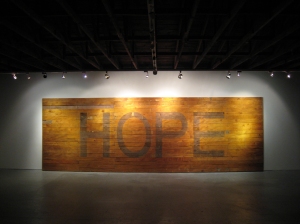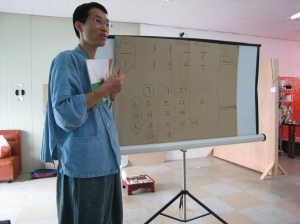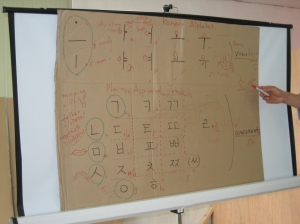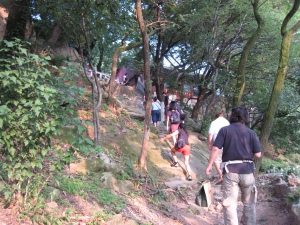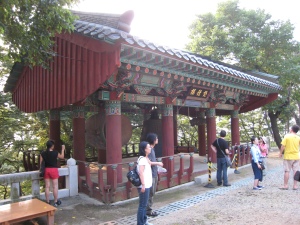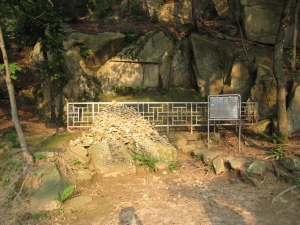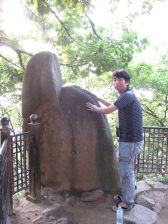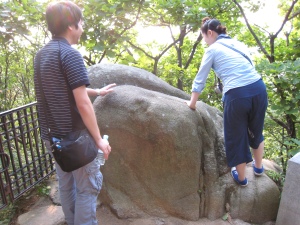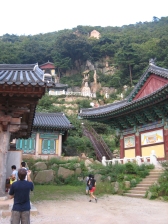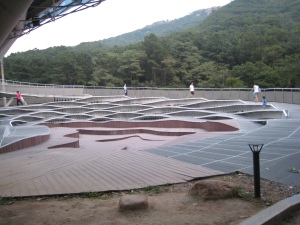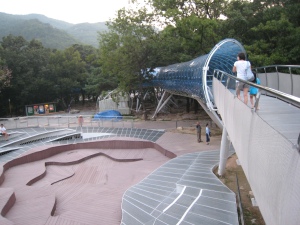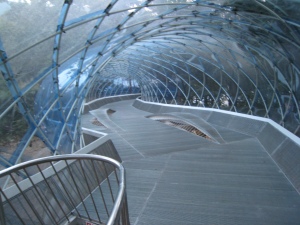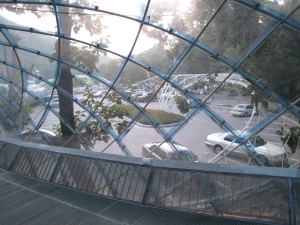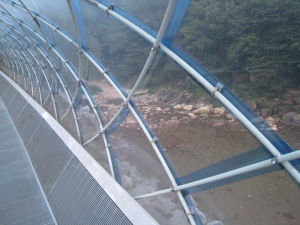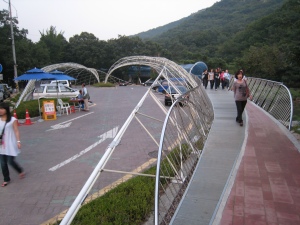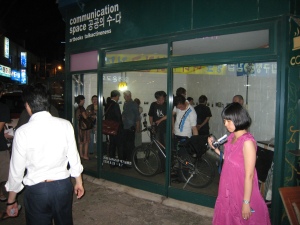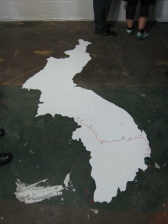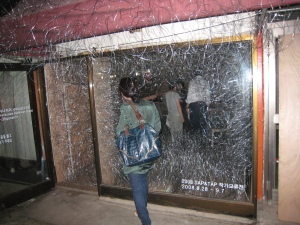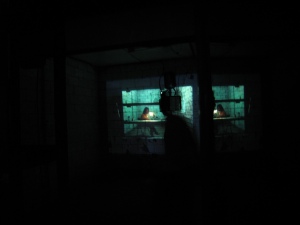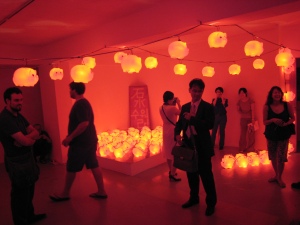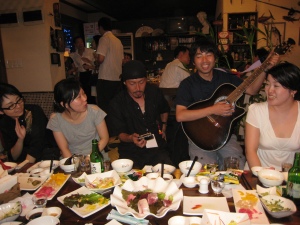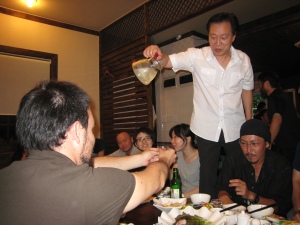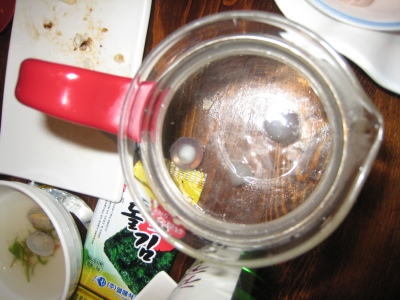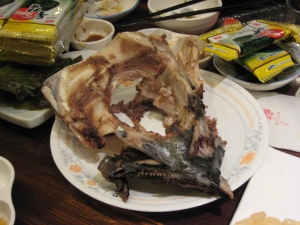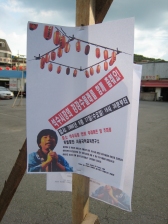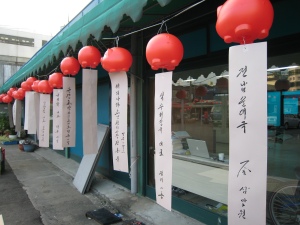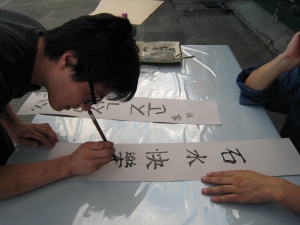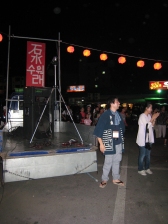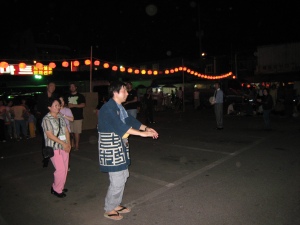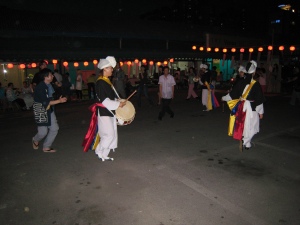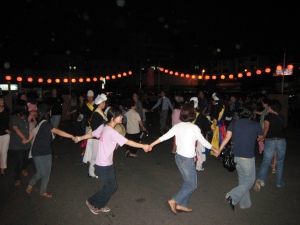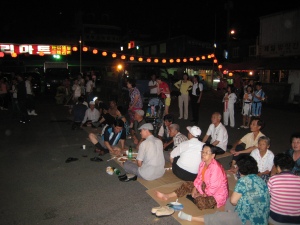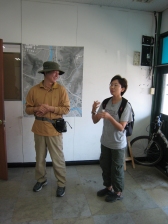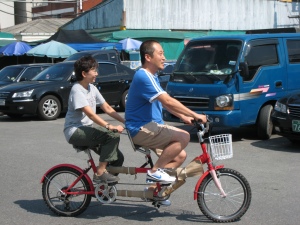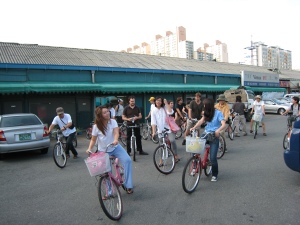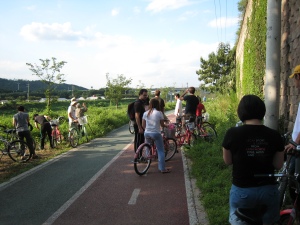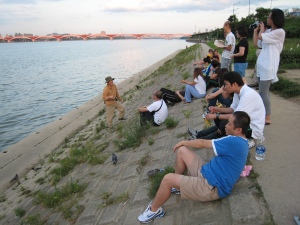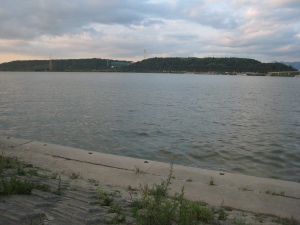The historical significance of Anyang River is one that is hard to gauge with observation alone. Its current landscape is the result of successful environmental restoration with abundant wildlife, un-kept grassy banks and a cycle/pedestrian lane that provides a variety of recreational use for nearby residents. In its recent history, Anyang River played a complex role in Korea’s industrial modernisation. In contrast to the current idyllic image, the river was once nicknamed Korea’s dirtiest river. Through a combination of industrial pollution and sewage the ecosystem was devastated and the stream and banks undesirable for recreational use. Many birds and fish one sees today had been absent for around 30 years.
During this period of rapid industrialisation a little known story illuminates the triangular relationship between industry, river and residents. Between the years 1974 and 1977 while Samduck paper and Samyoung hardboard factories poured industrial wastes into Suam and Samseong Rivers respectively (two of the tributaries of Anyang River), turning the rivers into bubbling toxic currents unable to support life, a small number of local residents found a way to make use of this nightmare.
Initiated by grandfather Mr Kang pools were made along the banks of Suam and Samseong Rivers to redirect the water. These pools collected water from the rivers and allowed the industrial waste to be deposited while the water seeped into the soil. Over a period of approximately one week, this drying process produced a large damp paper slab at the base of the pools. Depending on the volume of waste in the streams, the thickness of the slab varied. Local elderly women made extra income working along the riverbanks cutting the paper slab into damp paper blocks that were then sold back to Samduck or to an egg carton and wallpaper underlay factory in Sung-nam city. Other than the paper blocks, the residue left from this drying process was kept and used as fire fuel by the residents during winter.
The precursor of this activity occurred a decade earlier when waste produced by Hanguk paper factory accumulated and dried on the banks of Anyang River. The dried waste was much thinner and was collected by local residents to use as fire fuel for winter. However, it is not until the 70s that the aforementioned cyclical relationship between factory and the residents become apparent with the emergence of this cottage industry on the banks of the rivers.
My project is concerned with the history of paper block making along the banks of Suam and Samseong River. Due to an apparent lack of record of this activity, its history is survived mostly through oral accounts. Part of the motivation for my project is to gather and create new records for this history so that the memory may live on and be discussed through new channels of experience. Being an outsider and having no first hand experience of this history, my research methods are based on conversations and interviews with ![]() people who have observed and a site visit with grandmother Kim Jae Soon who had first hand experiences of the making of these paper blocks.
people who have observed and a site visit with grandmother Kim Jae Soon who had first hand experiences of the making of these paper blocks.
Kim Jae Soon who moved into Anyang in the early 70s was one of the women who made the paper blocks along the banks of Suam and Samseong River. She told me that all the other women were grandmothers at the time (therefore are unlikely to be alive today) except one who no longer lives in Anyang. She generously shared her past with me in two interviews. She fondly recalls the memory of Mr Kang but was brought to tears by the memory of economic hardship. Her account offered important insights into this story and has guided my decision making along many aspects of my project.
The project is divided into four parts, first an investigation into historical context by gathering accounts. Second: a site-specific work restaging the process of paper block making on the banks of Suam River. Third: a workshop led by Kim Jae Soon to offer a personal account of the experience of paper block making. Then finally from the site-specific work, both a photographic and sculptural outcome will be produced.
The method of research combined with the topic inevitably leaded to complications. Oral history is survived by memory and the practice of paper block drying was a very local one where Anyang citizens who didn’t live in the area at that time are unfamiliar with. From one person to another, conflicting accounts have emerged as people tussled with the task of recalling the past. My project aims to point to this past but does not wish to be presented as factual or authentic. The understanding to which I have arrived at is that the topic seems to be subject to multiple recollections and eludes closure.
Of the factories responsible for the extent of water pollution in Anyang River, the owner of Samduck recently donated his factory ground to the city as a gesture of compensation to the citizens of Anyang. This November the site will reopen as a city park. Of all the suggestions upon his donation as to what to do with the site, one suggestion was to retain the factory buildings and machines for a paper museum to remember its past. My project is empathetic to this proposal and is hopeful for future contributions to related history of Anyang.
-William Hsu, 2008
Anyang River today. The stone dam in the picture replaces a former concrete dam, which played a crucial role in slowing the current and allowing paper waste to be gathered.
Industries of Anyang in the 1960’s, Museum of Anyang History display.
Interview with grandmother Kim Jae Soon.
Photo from grandmother Kim Jae Soon’s family album. The picture shows Park Chan Hyub, Kim Jae Soon’s youngest son against the background of the Suam River, circa 1976.
Drawings made from interview sketches made by interviewee and translator.
Material source, local waste paper collection.
Process, pulp made using a concrete mixer.
Poster
Map
Workshop A Story of Paper Block Making from Memory led by Kim Jae Soon
Above: Workshop images
Above: Images of Open Studio Installation
03/09/08 Nick planned a flying visit on his way to rm103’s residency in Norway. On his arrival at Seoksu, Nick was warmly greeted by people in the market. The washbowl restaurant lady, the rice cake lady, the fish man and of course the staff here at SAP, all remembered him fondly from last year’s programme.
From left: Che Jinsuk, Nick Spratt and Elaine Tin Nyo
04/09/08 Nick and I spent the day going through galleries in Seoul. At night we went to Bupyeoung History Museum where our friends Elaine Tin Nyo and Che Jinsuk are part of an exhibition titled “Role Playing” that’s opening the next night. Later we visited Art Space Plastic, where Jinsuk had utilised spaces at her father’s plastic recycling factory for exhibiting art.
27/09/08 Our friend Monk Hong Dae Bong president of Anyang Buddhist art Gallery invited us to visit and stay the night at his temple up on Gwanak Mountain; the mountain between Seoul and Anyang. It was about a two-hour hike from the bottom of the mountain. Once we arrived we were treated with tasty vegetarian food grown from their own garden, then a tea ceremony followed by Monk Hong playing the bamboo flute. Hong also showed us a book of traditional Buddhist art. In the afternoon we climbed to many lookouts on the mountain, we had beautiful views of the cities. At night we drank plum wine while Hong played us his favourite music from around the world.
24/09/08 Daily Lee is a Korean SAP artist who is going over to Toride Art Project (TAP) as part of this year’s SAP and TAP exchange. His solo exhibition at Gwanhoon Gallery in Seoul is made up of three sculptures, all of which are beautifully crafted in wood. Downstairs there is a rowboat and a bucket with taps attached to it. Both objects are made from various Seoul artist’s studio floor. Upstairs is a massive wall piece previously installed as a public pedestrian floor bearing all the wear and tear of its time outdoors.
19/09/08 My good friend Mr Lim Jae Yeon, whom I stayed with in my first month in Korea generously offered to teach us foreign artists Hangul in a 3-hour lesson. Mr Lim is a citizen college teacher who specialises in teaching Hangul to elderly Koreans. In the first 45 mins we were shown a video about the history of Hangul. Then with little more then 2 hours to work with he managed to take us through all the alphabets of the Korean Language. He had an amazing way of associating sound with images and experiences i.e. sunrise and sunset. Once we got confident in putting sounds together he introduce us to common Korean words. It was surprisingly easy and immediately useful. It gave me a real appreciation of just what an achievement the invention of this phonetic system was.
29/08/08 After Tracing around Seoksu Market and Strolling along Anyang river, this day’s workshop was called “Groping”. I was perplexed and somewhat curious to see what was instore for us but mostly wondered whether that was a translation issue. We drove most of the way up a near by mountain Mt Samseongsan and walked to the Sammaksa Temple. It is a beautifully preserved mountain with natural forest all the way up. When we got to the top, before I realised where we were, all was revealed. No, no translation issue there. I was interrupted by Camera going “William! William!…” in a split second his water bottle was on the ground and he was”groping” the penis looking like rock with both hands. The legend has it to touch this rock will give you more man power and better chance of fertilizing someone. There was a female version too. Camera was keen to get a bit of that power as well and Sumi climbed on it. Pretty cool workshop. We then walked from the Sammaksa Temple to the Yeombulam Temple and then to the Anyang Public Art Park. It is a huge park, I had been here before with the US artists but seems like we only saw at most half of what is here. Mr Park joked about how the abbreviation APAP sounds like apa apa (it means sick in Korean).
The Acconci Studio work in APAP was impressive. Apparently, the construction deviated from his original design and that pissed him off, saying that the work is not his.
28/08/08 is the open studio day for the Toride Art Project (TAP) artists from Japan at SAP. This is the first year of the SAP & TAP exchange, the Japanese artists have been here fro a month and next month 3 selected Korean artists will go to Japan to stay and realise their projects.
Above: Suzuki Isao’s space where he showed pics and videos of a bike trip he made from Busan to Anyang.
Above: Kanazawa Sumi’s space, where she showed an installation based on the 38th parallel north and the novel Secret Garden.
Above: Woo-Young Kang, a Korean artist who is going to TAP this year’s video installation.
Above: Yamanaka Camera’s installation in Stonenwater gallery with objets from and a video documentation of his performance last night.
Above from left: Niko (Toride City Culture Manager), Ami Nakayama (Toride Art Project), Suzuki Isao, Yamanaka Camera and Kanazawa Sumi.
Our host Ho Jin Susang treated us to a Korean sushimi place following the open studio. The chef look suspiciously like Christopher Walker to me. We had plates after plates of the finest tuna cuts. Once we’ve stuffed ourselves with tuna sushimi, the chef brought out his “special cocktail” in a coffee jug and pour it into our soju glasses. It was oily. By then, I had already had quite a number shots of soju. Half way through this “special cocktail” I found out that the things floating inside the coffee jug are not ice cubes, they are tuna eye balls! Man, pretty extreme. The night seemed to just keep going and going. When we thought we’ve had all we can eat, the chef grilled the tuna head and served it to our table. Suzuki was happy to see the tuna head and got stuck right in there.
27/08/08 We knew we were in for something big since the arrival of the 108 pig coin boxes in the studio few weeks ago. For his final performance in SAP, Camera has composed a new song for the Seoksu Market based on the traditional Ganggang Suwollae; a dance Koreans do during the full moon. The pig coin boxes, they were transformed into lanterns and hung around the market. Crates of mak-gul-li arrived in the afternoon as well as an calligraphy master who wrote desires/wishes on long strips of paper to hang on the lanterns, this was a tradition all participants were invited to partake, so we happily joined in.
At night, Camera’s performance was accompanied by a group of traditional Chang-go drummers. They played around the outside of the market before making an entrance into the centre of the market. The atmosphere was festive, many locals came to the occasion and many joined in in the Seoksu Suwollae. It was a beautiful project. A huge success.
Artist Daily and Jayeon warming up for the 20Km ride.
26/08/08 The workshop Strolling took us from the Manan Bridge in Anyang to the intersection between Anyang River and the great Han River in Seoul. A 20km bicycle ride along a very scenic and cycle friendly track. To begin, we were introduced to a brief history of Anyang river by our guide, environmental educator Mr Ahn in our studio. Then we were off, along the Anyang river towards Seoul. During our breaks Mr Ahn spoke of how the return of the Great egret is hugely symblic for a healthy river as the bird can only nest on the wetlands here. Also we were told that one of the migratory birds, Cormorant travels all the way to New Zealand.
Across the Han River we were shown two artificial hills that was the former landfill. Between the hills I was told that there is a famous artist residency programme. But it might not be there for long as they are considering on putting a furnace in its place.
